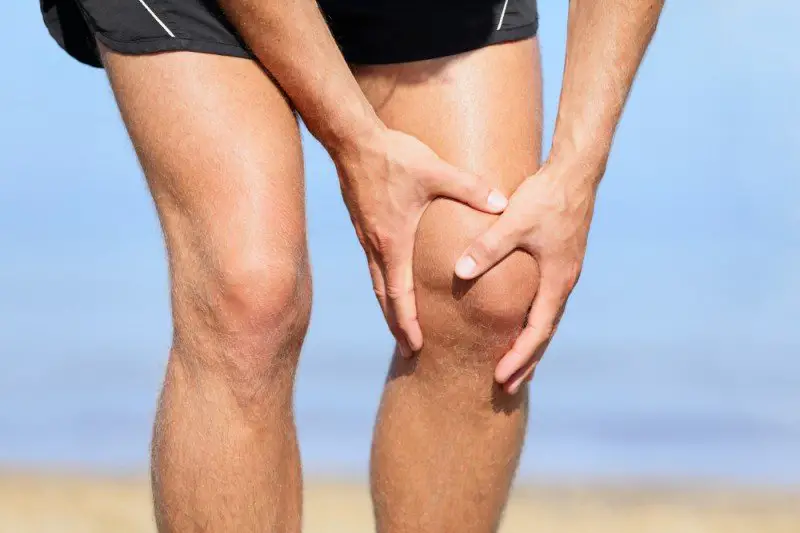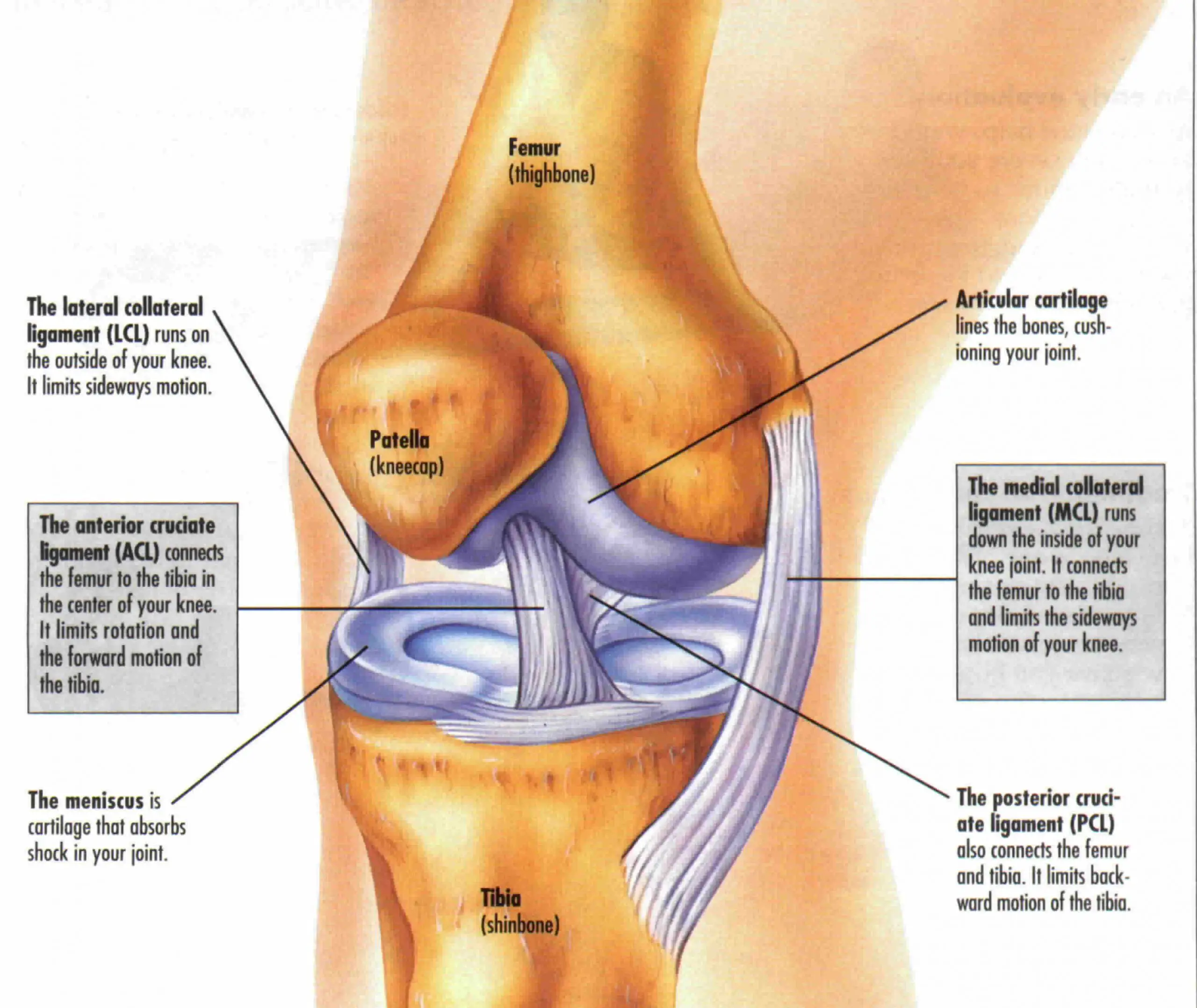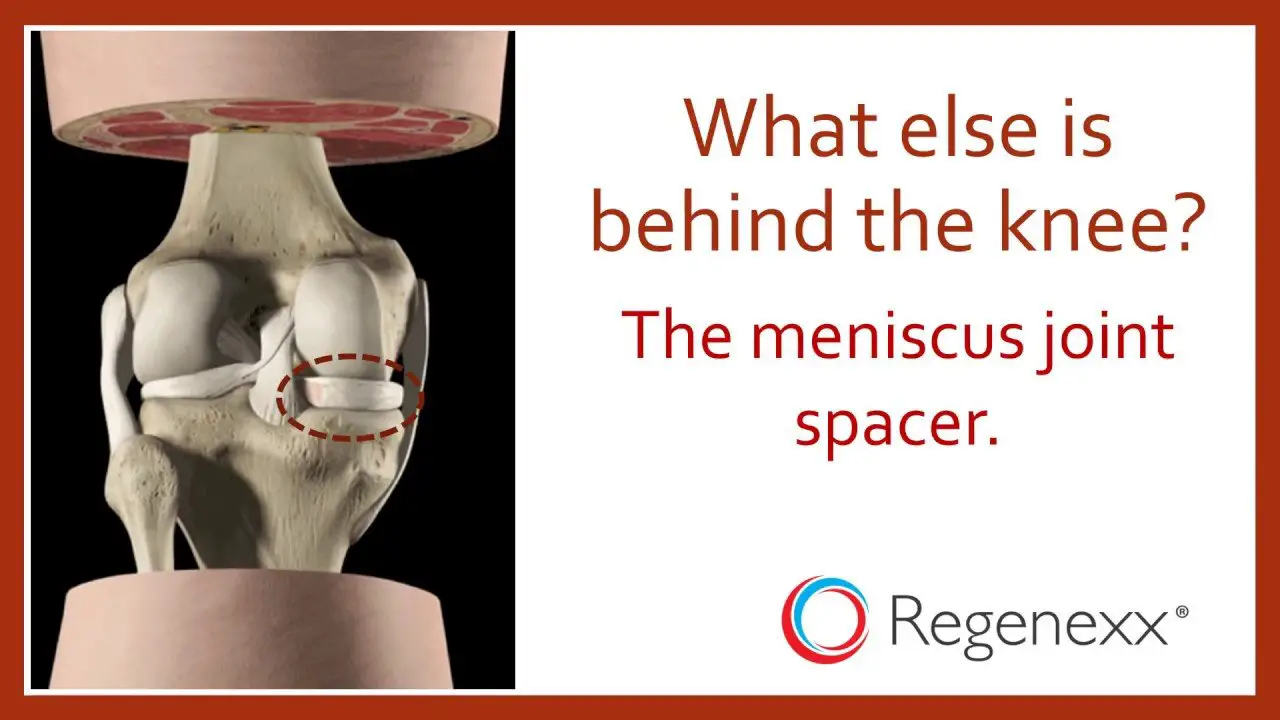A Popping Sensation Behind The Knee Or Pain And Stiffness At The Side Of The Knee
May be the result of a torn meniscus, particularly the posterior horn of the meniscus. This can often occur due to an impact or twisting sports injury, and is more likely as one gets older and the meniscus becomes worn. Pain might not be evident until some time after the injury occurred. RICE may temporarily alleviate the symptoms, but the tear will often require a surgical procedure.
Whats Behind The Knee
The back of the knee has complicated anatomy.
As well as the knee joint that sits in the middle, there are muscles from the thigh and calf that pass through this area. Firstly, the large hamstring muscles start from the pelvis and pass across the knee to attach to the lower leg bones. In addition, the large calf muscles start at the bottom part of the thigh and cross the knee to form the large Achilles tendon.
Finally, there are important nerves and blood vessels that cross the back of the knee to supply the lower leg and foot.
I Have Just Injured My Leg And Have Severe Pain At The Back Of My Knee What Should I Do
A sudden, sharp, pain in the thigh or behind the knee may be a torn hamstring, or possibly a tear in the posterior part of the meniscus. Alternatively, if you have sudden pain and instability after an injury, perhaps accompanied by a popping sound, you may have damaged a knee ligament. It could also be a ruptured Bakers cyst. In these cases, whilst RICE is recommended initially, you should go to your doctor and have the knee clinically assessed.
Recommended Reading: Will Naproxen Help Back Pain
Pain Behind Knee: What Should You Do
In general, pain behind the knee is one of the more challenging musculoskeletal problems. There are so many possible causes muscle tear, tendon, nerve damage, and blood clots. Like most other problems, the key to managing it correctly is an early and accurate diagnosis. So, what are the causes of pain behind the knee, and how do sort out what is causing the problem?
Sciatic Nerve Links The Back To The Legs

The most common back ailments that cause pain in the knees are related to the sciatic nerve. If you have back pain and feel a shooting sensation originating from your lower back running down your leg and through your knee, your sciatic nerve is to blame.
As the longest and largest nerve that runs through the body, the sciatic nerve if damaged or compromised can cause debilitating pain. The condition is called sciatica, and it is often the byproduct of a degenerative nerve condition or an injury .
When any part of the spine puts pressure on the sciatic nerve, the result may be shooting pain or a tingling sensation that travels from the back down to your hips, buttocks, knees, and feet.
Also Check: How Much Advil Can I Take For Back Pain
Common Causes Of Pain Behind The Knee
Sometimes pain behind the knee is simply due to muscle strains. These injuries usually heal in a matter of days. However, this is only one possibility. There can also be pain behind the knee as a result of systemic diseases or some life-threatening conditions. Below we take a look at just what the different potential causes are.
How Does A Doctor Diagnose Gout
If you have sudden or severe pain in a joint, you should talk to your primary care provider . Your PCP may send you to a rheumatologist, a doctor who specializes in gout and other kinds of arthritis.
Healthcare providers consider several things when confirming gout:
- Symptoms: The provider will ask you to describe your symptoms, how often they happen and how long they last.
- Physical examination: Your provider will examine the affected joint to look for swelling, redness and warmth.
- Blood work: A test can measure the amount of uric acid in your blood.
- Imaging tests: You may have pictures taken of the affected joint with X-rays, an ultrasound or MRI.
- Aspiration: The provider may use a needle to pull fluid from the joint. Using a microscope, a team member can look for uric acid crystals or a different problem .
You May Like: Is Aleve Or Ibuprofen Better For Back Pain
Chronic Pain Behind The Knee
Pain at the back of the knee may occur gradually. You are unlikely to be able to pinpoint the exact time your injury occurred. These injuries often start out as a niggle which you may attempt to ignore. Eventually, they become progressively worse.
An acute injury may become chronic if it is not treated properly, or fails to heal.
Chronic knee injuries can be more difficult to treat so do not ignore the early signs!
How Do I Know If My Knee Pain Is Not Serious
If your knee pain is in that first group rather than that second group, that is likely a good sign that you are dealing with something less concerning. One way to gauge your knee pain severity is to see how it will respond to simple at-home therapy.
Rest and ice your knee, and take over-the-counter pain medication like acetaminophen or naproxen. If those measures relieve your symptoms, it is likely you are dealing with something minor. If you are worried about the state of your knee, you can see a doctor who can determine if nothing is seriously wrong with it.
Read Also: Will Aleve Help Back Pain
Burning Pain In Knee Cap
When you feel pain in your knee cap, you imagine the worst. You begin to believe you’ve injured your knee. Maybe you even wonder if you have a torn meniscus.
Burning pain under or around your knee cap is a common overuse injury. The official diagnosis for this syndrome is chondromalacia or patellofemoral pain syndrome, also known as PFS. The injury is also commonly known as runner’s knee.
When you run, you put stress on your knee cap and the tendons in it. If you’re not used to running long miles and attempt a long run, you will feel this pain. You will also feel it if you begin to increase your mileage too quickly.
Your tendons in your knee cap are firing up and becoming inflamed. You have tendonitis in your knee or runner’s knee.
Stopping activity will help this heal more quickly as will ice and appropriate NSAID or anti-inflammatory medications.
Blood Clots Behind Knee
It is important to note that pain and swelling behind the knee may be associated with blood clots. Blood clots behind the knee are especially common for those on bed rest or prolonged laying down, recovering from surgery or who have experienced trauma to the knee. Age and weight may also be a factor in blood clots. If you are experiencing behind knee pain, see a doctor to diagnose your situation, especially as you may be experiencing a blood clot behind knee.
Recommended Reading: Aleve And Back Pain
What Does A Gout Attack Look And Feel Like
Symptoms of a gout attack on joints are similar no matter which joint is affected. When gout flares up, you will experience extreme pain and stiffness in the affected joints and the area will also be red and warm to the touch. Inflammation from the gout attack can also affect your entire body in the form of a fever, chills, fatigue, and achiness.
Burning Pain When Sitting Still

Some people feel more pain at night than during the day.
You might feel more pain when you’re sitting still. Some of us are just too busy to monitor pain. We need debilitating pain to tell us to slow down and be still.
So when you sit down and take a break, do not be surprised if the little niggles of pain begin to visit you.
Your nightly knee pain can also come from reduced hormone signals. When you rest, your hormone signals are reduced. These reduced hormone signals give way for pain signals to reach the brain.
So you’ll feel pain as you try to nod off.
Your blood vessels may also be the culprit for pain at night. When you sleep, your blood vessels increase in diameter. This is a natural process that allows more blood to come to muscles, allowing them to heal.
However, those expanding blood vessels can put pressure on your nerves. This will cause pain such as pain in your knee even as you try to sleep.
Read Also: Mayo Clinic Low Back Pain Exercises
What Does It Mean When The Back Of Your Leg Hurts Behind The Knee
Pain at the back of your knee when bending depends on several factors. These include how the pain started, your age, medical history, and so on.
If you are an athlete and/or play contact sports often, you could have:
- A hamstring or gastrocnemius tendinitis
- Pes anserine bursitis
If youre over 60 years old, you could have:
- A leg cramp
- Bakers cyst
- Knee arthritis
- DVT.
If youre not sure or if youve had pain for more than 6 weeks, go to the doctor to find out whats going on.
Can Growing Pains Occur In Just One Leg
Usually growing pains occur bilaterally or in both legs. These pains usually occur deep in the thigh or calf in school-aged children. They generally occur at night with resolution by morning. If your child is experiencing pains in just one leg, consider bringing them for medical evaluation. One-sided leg pain can be indicative of infection, musculoskeletal injury or deformity, or other serious conditions such as a tumor.
Recommended Reading: Advil Or Aleve For Back Pain
What Are Home Remedies For Hamstring Injury
The goal of treatment is to restore muscle function and prevent scar formation. Initially, treatment consists of rest, ice, compression, and elevation . Rest refers to avoidance of offending activities and oftentimes includes immobilization. In severe cases, crutches or splinting may be necessary. Ice, compression, and elevation all help in controlling pain and swelling. A short course of nonsteroidal anti-inflammatory medication, such as aspirin, ibuprofen , or naproxen , may be helpful .
Is It Possible For Adults To Have Growing Pains
No one knows for certain what causes âgrowing pains.â They are defined as self-limited and recurrent pains in the extremities of children with no other explanation or clear musculoskeletal causes. These usually occur during sleep and may awaken the child. Some physicians believe they occur due to fatigue, overuse, and mild orthopedic abnormalities, but the cause is still unknown. No matter what causes growing pains, we know that adults do not have them â most growing pains occur between age 2 and 12. It is possible to have similar pains, however, due to very mild injuries or overuse of muscles.
Read Also: How Does A Diuretic Help Back Pain
Tennis Leg Causing Muscle Pain And Swelling Behind The Knee
A condition called tennis leg can also cause pain in the back of your leg behind the knee.
Tennis leg is associated with damage to the gastrocnemius where damage to the muscle and the soleus muscle in the calf causes a buildup of fluid.
According to the journal Radiology Case Reports, tennis leg is often a result of sports injuries. Damage to the calf muscles can cause swelling and pain in the posterior knee.10
If The Back Of Your Knee Feels Tight Or Stiff:
You may have Osgood Schlatters Disease. This is an inflammation of the area just below your knee where the tendon of the kneecap attaches to the shinbone. It occurs during growth spurts or times when bones, muscles, and tendons are changing rapidly. Other symptoms include knee pain and tenderness or swelling.
Don’t Miss: Advil Vs Ibuprofen For Back Pain
About : : : : Of People Who Have Had Dvt Or Pe Are At Risk For Another Episode
Once you had a DVT/PE you are at risk of for another event. Based on follow up studies with patients who had a DVT or PE, it is estimated that about 25% will have another episode. This risk can be decreased by anticoagulation therapy . Unfortunately being on a blood thinner for prolonged periods had risk factors as well. Talk to your doctor about the best approach for your individual case.
What Increases Your Chances For Gout

The following make it more likely that you will develop hyperuricemia, which causes gout:
- Being male
Also Check: Ginger Poultice For Knee Pain
Recommended Reading: Advil Good For Back Pain
Knee Pain: What Causes It What Can You Do About It
If you type knee into Google, the suggested topic that pops up first is knee pain.
Thats not a coincidence. At some point, most of us have experienced knee pain caused by everything from everyday wear and tear to sports, recreation or injuries. It knows no age, either. Depending on your activity level and health, you could experience knee pain as a young person, or as a senior.
Hamstring Injury And Pain At The Back Of The Knee
An injury to your hamstring is a very common reason for sharp pains at the back of your knee.
Your hamstring starts at the bottom of your pelvic bone and crosses the back of the knee and ends at the lower leg. Doctors from the American Academy of Orthopedic Surgeons say that your hamstring helps you bend your knee.
Hamstring injuries can result in pulling the hamstring muscle or completely tearing it. This can result in pain at the back of your leg below your knee. You may also notice bruising of your leg and may find it difficult to walk for a few weeks.3
Dr. Tyler Wheeler on WebMD says that you can prevent hamstring injuries by warming up before exercising. You should also strengthen your glutes which make up your buttocks to prevent extra strain on your hamstring muscles.
At the end of the article, you can find out how to treat a pulled or torn hamstring and help ease the pain behind your knee.
Don’t Miss: Aleve Or Ibuprofen For Back Pain
Risk Factors For Pain In The Back Of The Knee
Following are the risk factors that may trigger pain in the back of the knee
Medications for Posterior Knee Joint Pain-
Physical Therapy for Posterior Knee Joint Pain- Physical therapy is beneficial once the pain intensity is tolerable. Leg muscle atrophy and weakness is observed when knee joint pain is treated with rest for several days. Few cases are treated with application of cast or braces over knee joint that results in loss of muscle mass. Such cases are treated with aggressive physician therapy. Physical therapy helps to rebuild tone, power and coordination of muscle.
Surgery for Posterior Knee Joint Pain- Surgery is necessary if posterior knee joint pain is caused by fracture or dislocation of knee joint. Surgery may involve instrumentation or close reduction of fracture and dislocation.
If You Have Leg Pain In The Back Of Your Knee Or Calf:
This is most likely a symptom of gastrocnemius tendonitis . The gastrocnemius muscle, which is the muscle that makes up your calf, controls the bending of your knees and the pointing of your toes. A sport that requires you to accelerate quickly can strain or tear the calf muscle. Other symptoms include swelling and bruising of the calf or trouble standing tiptoe.
Don’t Miss: Exercise For Lower Back Pain Mayo Clinic
Knee Pain Caused Within The Joint Structure
Unsurprisingly, pain behind the knee can also be correlated with issues within the knee joint itself.
Because the joint has such a complex structure , any deficiency or injury has the potential to impact the kind of pain you experience.
However, when were looking specifically at pain behind the knee, there are two primary culprits
What Is The Treatment For Hamstring Injuries
Most hamstring injuries heal without surgery. Rarely, when there is a complete rupture at the ischium, or when a significant piece of ischial bone is jerked away, surgery is necessary. Essentially, all other grade I-III tears are best treated without surgery.
As soon as pain permits, it is important to begin a program of stretching and range-of-motion rehabilitation exercises because prolonged immobilization and inactivity results in muscle shrinkage and scar tissue . Excessive scar tissue is incompatible with healthy muscle function. Atrophy and fibrosis are best avoided or reduced by a program of motion and stretching implemented early in the rehabilitation process.
It should be emphasized that an early rehabilitation program does not mean a quick return to the desired usual activity. Given the type of individual that usually sustains a significant hamstring injury, it is usually a difficult task to keep athletic patients off the playing field. Reinjury is extremely common and is often due to avoidable premature return to sport. Reinjury not only prolongs recovery, it also increases the risk of permanent damage. People with these injuries should be informed early in the rehabilitation program about the risks of reinjury.
Read Also: Back Pain Advil